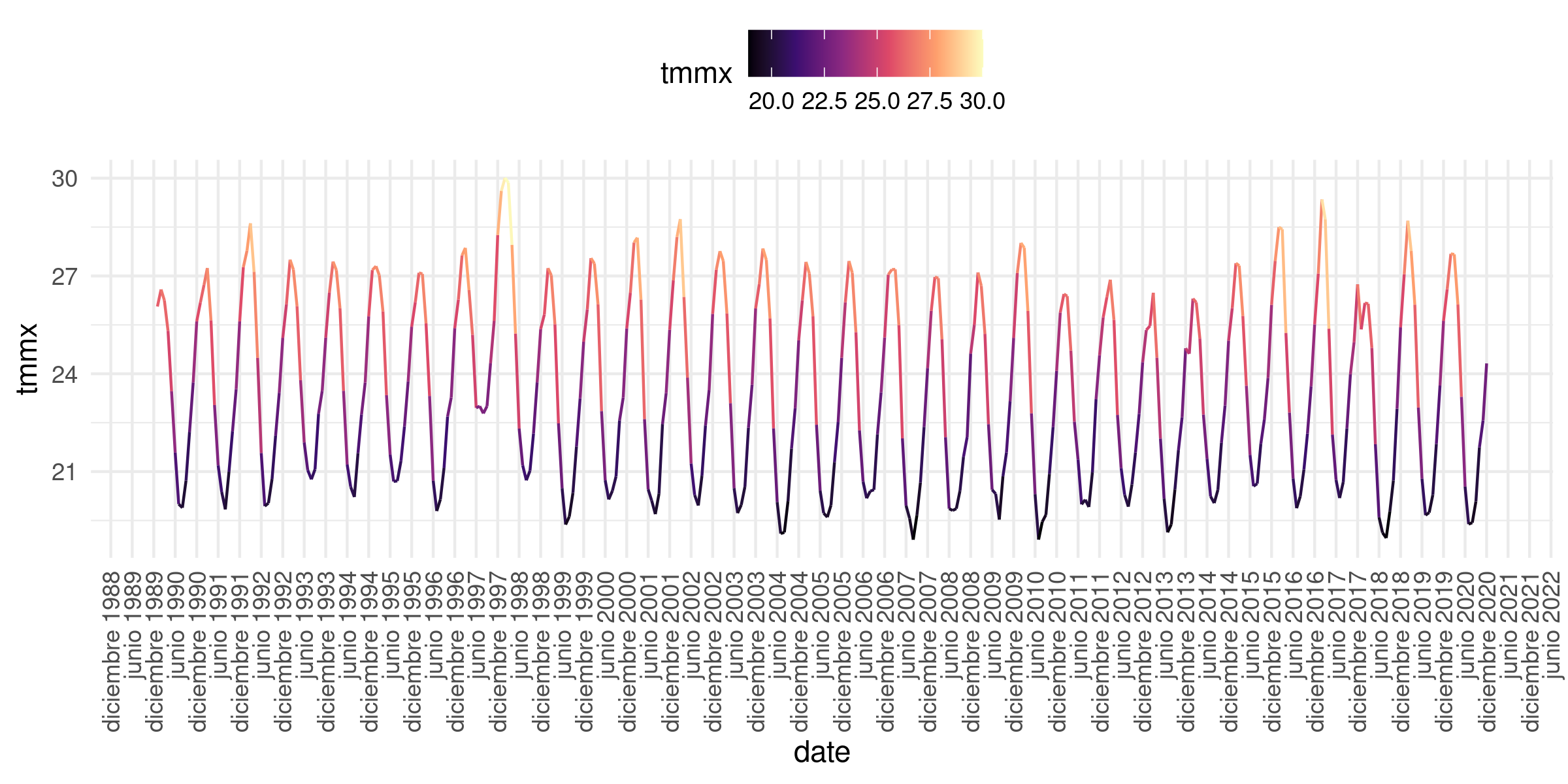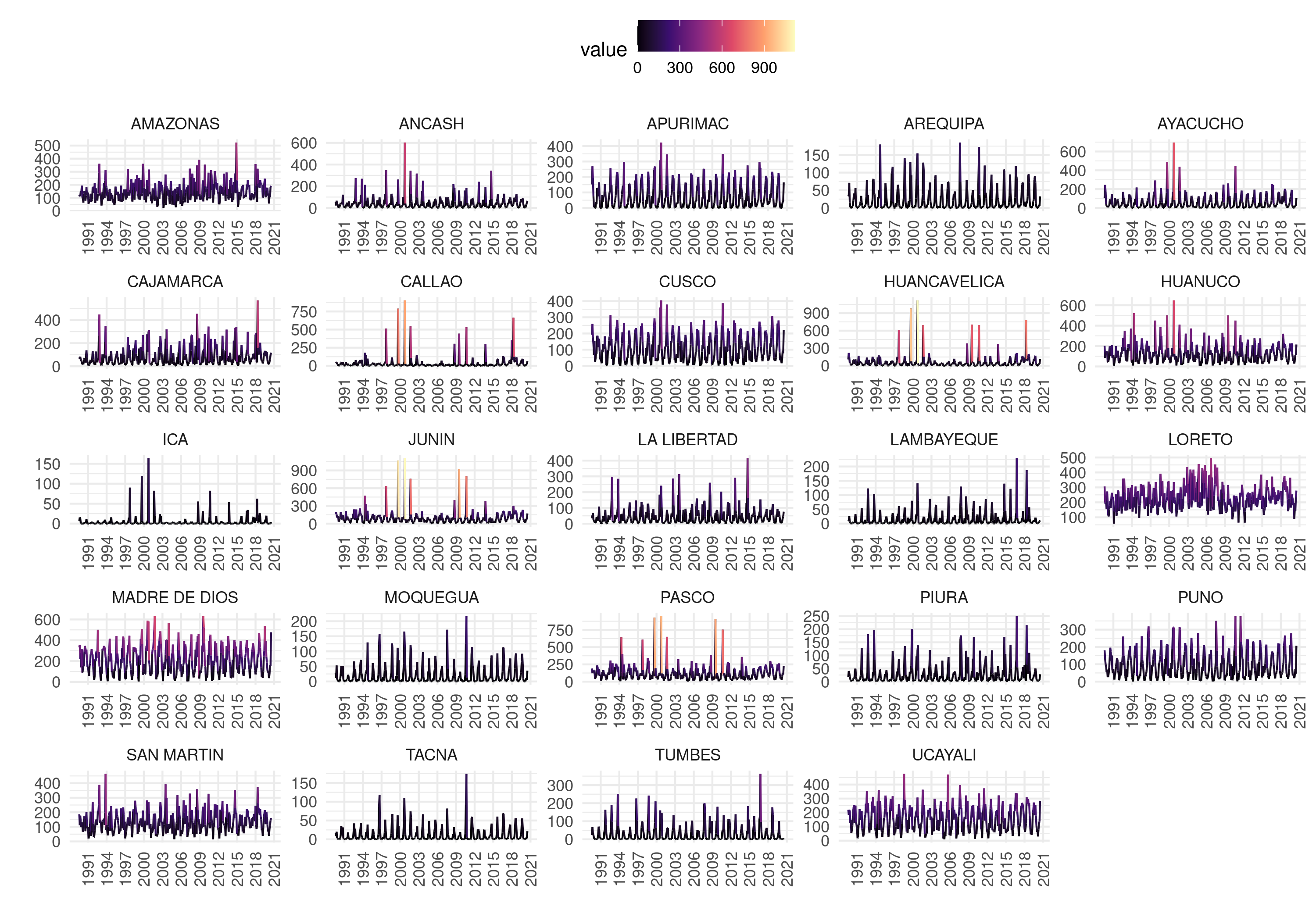2. Extraction of a large time series of meteorological variables
The objective of this demo is to extract a time series of meteorological variables like temperature and precipitation in Lima and the 24 departaments using the dataset of Terraclim.
 Information: Information: |
- For this demo you need to have rgee, sf, tidyverse and lubridate packages previously installed. |
2.1 Requirements
library(rgee)
library(sf)
library(tidyverse)
library(lubridate)
ee_Initialize()── rgee 1.1.2.9000 ──────────────── earthengine-api 0.1.297 ──
✓ user: not_defined
✓ Initializing Google Earth Engine: DONE!
✓ Earth Engine account: users/antonybarja8
────────────────────────────────────────────────────────────── 3.2 Reading vector layer of study area
lima <- st_read(
"https://github.com/healthinnovation/sdb-gpkg/raw/main/Lima_provincia.gpkg",
quiet = TRUE) %>%
summarise()2.3 Transformation of sf object to a feature collection
lima_ee <- lima %>%
sf_as_ee()2.4 Processing data with rgee
terraclim <- ee$ImageCollection$Dataset$IDAHO_EPSCOR_TERRACLIMATE$
select(c("tmmx","pr"))$
filterDate("1990-01-01","2021-12-31")$
toBands()
# Extracting data
lima_data <- ee_extract(
x = terraclim,
y = lima_ee,
fun = ee$Reducer$mean(),
sf = FALSE)2.5 Processing data for mapping
lima_temp <- lima_data %>% as_tibble() %>%
mutate(region = "LIMA") %>%
pivot_longer(X199001_pr:X202012_tmmx) %>%
separate(col = name,into = c("date","variable"),sep = "_") %>%
mutate(date = ym(gsub("X","",date))) %>%
separate(col = date,into = c("year","month"),sep = "-") %>%
mutate(month = factor(month,labels = month.abb))2.6 Time series plot - Lima
# Maximum temperature
lima_temp %>%
pivot_wider(names_from = variable,
values_from = value) %>%
mutate(date = ymd(paste(year, month, "01", sep = "/"))) %>%
ggplot(aes(x = date, y = tmmx, col = tmmx)) +
geom_line() +
scale_x_date(date_breaks = "6 months",
date_minor_breaks = "6 months",
date_labels = "%B %Y") +
scale_color_viridis_c(option = "magma") +
theme_minimal() +
theme(axis.text.x = element_text(angle = 90, vjust = 0.5, hjust=1),
legend.position = "top")
2.7 Time series plot for the 24 departaments of Peru
# Reading vector layer
dep <- st_read(
"https://github.com/healthinnovation/sdb-gpkg/raw/main/departamentos.gpkg",
quiet = TRUE) %>%
dplyr::select(NOMBDEP)# Time estimate ~ 12 min
dep_list <- list()
for(i in 1:nrow(dep)){
dep_ee <- dep[i,] %>% sf_as_ee()
pet <- ee_extract(
x = terraclim,
y = dep_ee,
fun = ee$Reducer$mean(),
sf = FALSE)
dep_list[[i]] <- pet
}# Processing data for mapping
dep_pet <- dep_list %>%
map_df(.f = as_tibble) %>%
pivot_longer(X199001_pr:X202012_tmmx) %>%
mutate(variables = gsub("[^prtmmx]", "", name) ,
date = gsub("\\D", "", name) %>% as.integer()) %>%
mutate(value = case_when(
variables =="pr" ~ value,
variables == "tmmx" ~ value *0.1))# Accumulated precipitation
dep_pet %>%
mutate(date = ymd(sprintf("%s01",date))) %>%
filter(variables == "pr") %>%
ggplot(aes(x = date, y = value, col = value)) +
geom_line() +
scale_x_date(date_breaks = "36 months",
date_minor_breaks = "36 months",
date_labels = "%Y") +
scale_color_viridis_c(option = "magma") +
theme_minimal() +
theme(axis.text.x = element_text(angle = 90, vjust = 0.5, hjust=1),
legend.position = "top") +
facet_wrap(~NOMBDEP,ncol = 5 , scale = "free") +
labs(x = "" , y = "")